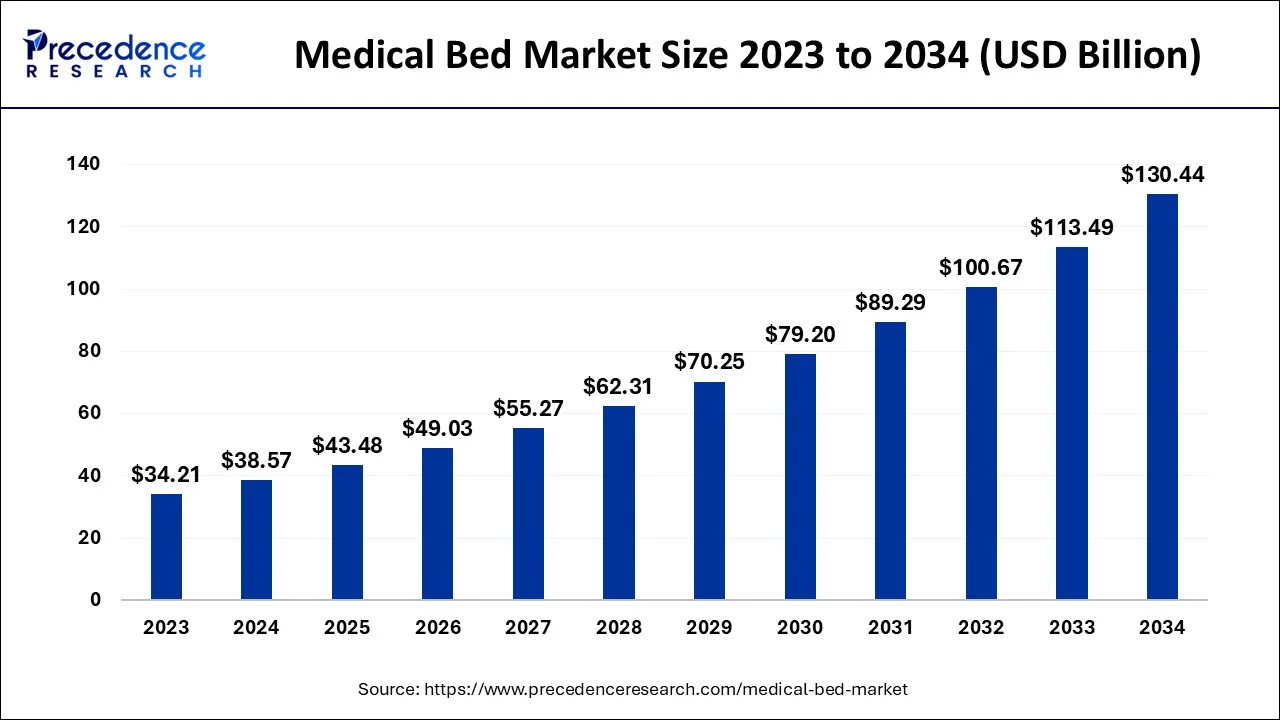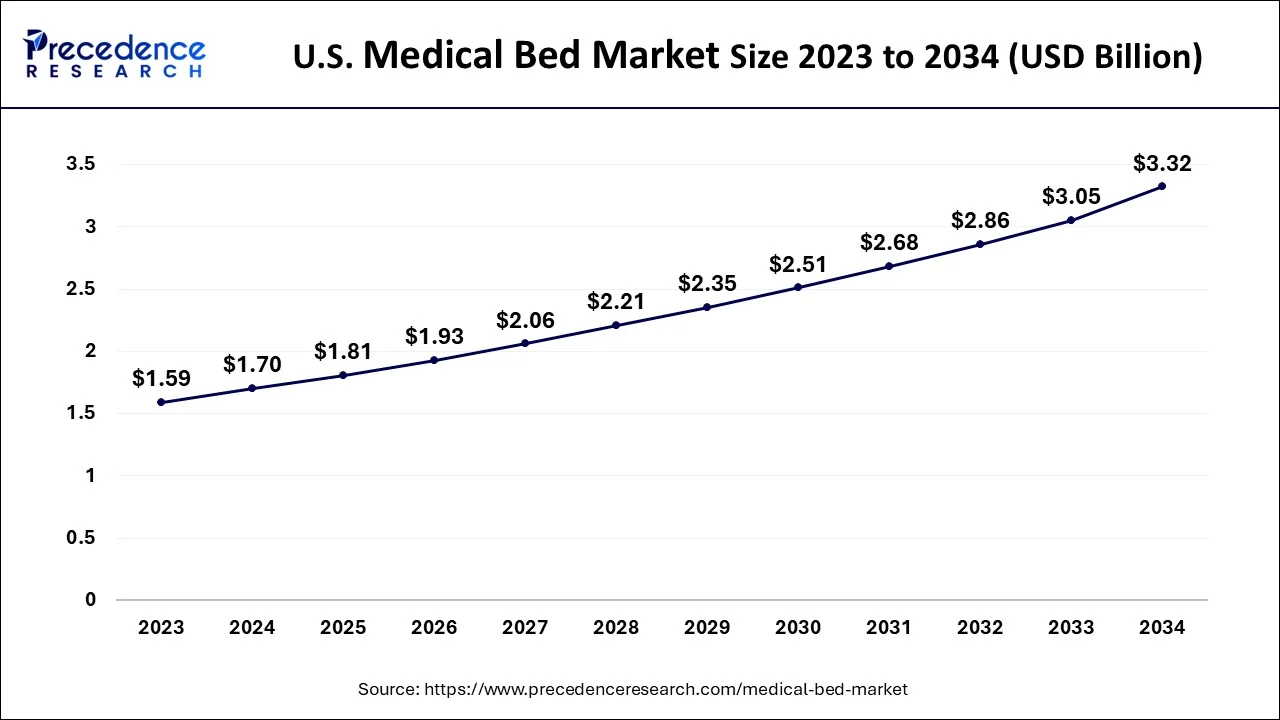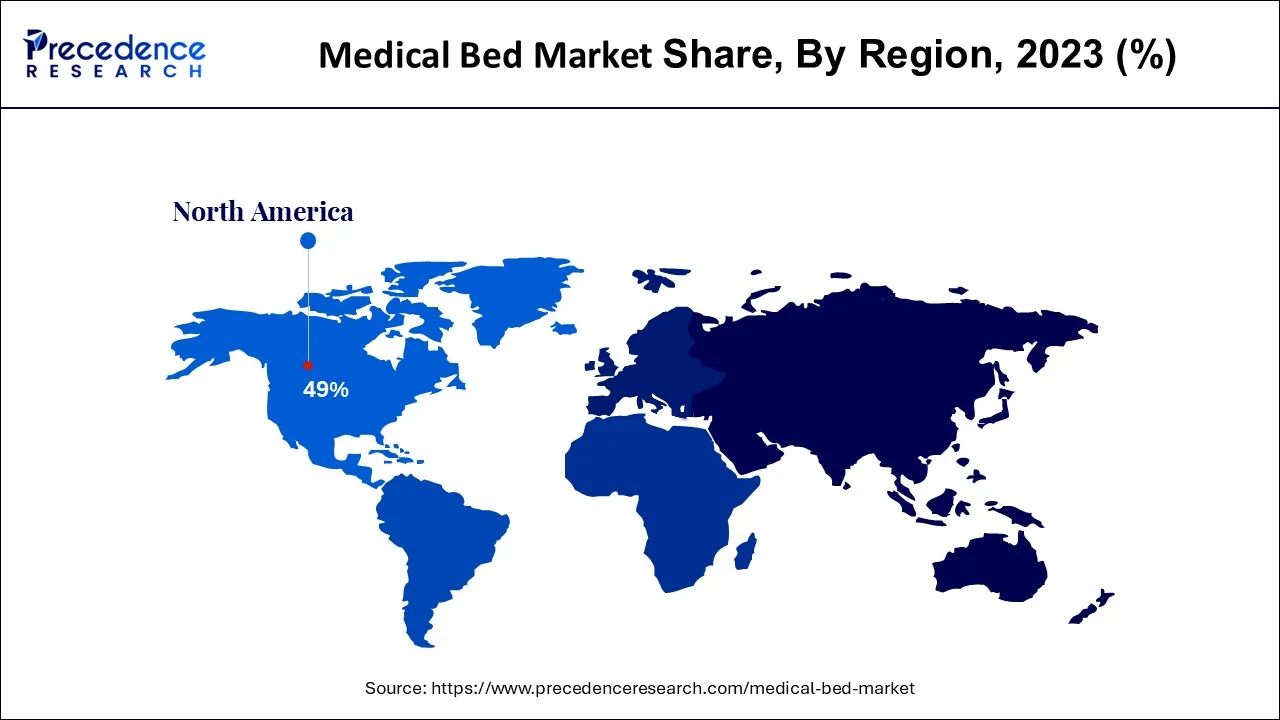What is the Medical Bed Market Size?
The global medical bed market size is valued at USD 43.48 billion in 2025 and is predicted to increase from USD 49.03 billion in 2026 to approximately USD 147.39 billion by 2035, expanding at a CAGR of 12.98% from 2026 to 2035.

Medical Bed Market Key Takeaways
- North America dominated medical bed market in 2025.
- By product, the electric bed market dominated the market in 2025.
- By application, the outpatient clinics segment led the market in 2025.
- By usage, the acute care segment will gain a significant market share over the forecast period.
Market Overview
Medical beds, which range from manually controlled to fully electric, guarantee the patients' comfort while also having cutting-edge features. Additionally, it is projected that the market would rise as a result of healthcare providers' increasing expenditures on hospital infrastructure and patients' access to affordable treatment worldwide. The market is anticipated to increase as a result of factors like the expanding geriatric population and the prevalence of chronic illnesses worldwide. Over the projected period, the market for medical beds is expected to expand at a CAGR of almost 5.8%.
Furthermore, throughout the course of the forecast period, the market is anticipated to rise as a result of technical advancements, the adoption of medical beds, and an increase in the number of hospitals. However, it is projected that the market expansion would be hampered by the high cost of medical beds and a decline in the number of beds in public hospitals.
Medical Bed Market Growth Factors
Medical beds are the equipment used in hospitals for patients who are bedridden or in need of care. Medical beds make it easier to transfer patients, improve patient placement, and reduce the chance that they may roll out of bed.
Patient beds known as manual medical beds are those that can be adjusted manually for the comfort of the patient. Manual medical beds are predicted to support the segment's growth throughout the forecast period because they are less likely to have a motor failure, are less expensive, and have simple operating mechanisms. Due to rising expenditures on hospital infrastructure and an increase in the number of organized hospitals throughout the world, the electric bed market is predicted to develop at a substantial rate.
According to the World Population Ageing Report, the proportion of elder people worldwide, which was about 89.3% in 2020, may rise to 16% by 2050. Furthermore, it is predicted that the market would increase during the forecast period due to the rising elderly population and lifestyle illnesses that require medical beds for better treatment and comfort.
According to the end user, the homecare sector is expected to see rapid market expansion due to the use of medical beds in homecare settings and the rising number of diabetes patients worldwide.
Market Scope
| Report Coverage | Details |
| Market Size in 2025 | USD 43.48 Billion |
| Market Size in 2026 | USD 49.03 Billion |
| Market Size by 2035 | USD 147.39 Billion |
| Growth Rate from 2026 to 2035 | CAGR of 12.98% |
| Base Year | 2025 |
| Forecast Period | 2026 to 2035 |
| Segments Covered |
By Type,By Application,By Usage |
| Regions Covered |
North America,Europe,Asia-Pacific,Latin America, andMiddle East & Africa, |
Market Dynamics
Key Market Drivers
- The frequency of chronic illnesses is increasing - The frequency of chronic illnesses is increasing, and consumers are becoming more interested in hospital beds that are well-equipped with cutting-edge features. Additionally, postoperative care and home healthcare services for the elderly population provide market participants with significant potential.
- The National Health Council research estimates that 40 million Americans experience limitations in their daily activities as a result of one or more chronic health issues. According to a survey released in 2019, 133 million Americans or more than 40% of the population have incurable chronic conditions. Many people struggle not just with one but with two or more chronic ailments, such as diabetes, heart disease, or depression. The demand for hospital beds is fueled by the possibility that a high incidence of chronic illnesses may increase the need for hospitalization.
- 80% of general practitioner (GP) consultations and 60% of hospital bed requirements, according to estimates in a study by the Department of Health & Children, are connected to cases of chronic diseases with accompanying problems. Acute care hospital beds are accessible for curative care, with 100,000 beds per population in Europe, according to research by the Data and Digital Health Unit. These beds can accommodate patients for a variety of medical procedures, including conducting operations, treating non-mental disease symptoms, managing labor (obstetrics), healing non-mental sicknesses or offering conclusive therapies for injuries, and more. Every year in the US, addressing chronic illnesses receives around 75% of healthcare spending. 8 of the top 11 reasons for hospitalization in the UK, as estimated by the Department of Health & Children report, are related to chronic diseases, and 5% of inpatients have long-term disorders, occupying 42% of hospital beds.
- Diabetes and heart diseases, among other chronic conditions - The major causes of mortality and disability in the US are chronic disorders like diabetes and heart disease. For instance, the most prevalent chronic illnesses affecting more than one in four persons in California in 2019 were high blood pressure and obesity. Additionally, there were 700 hospitalizations per 100,000 persons in California among those with chronic diseases, representing high hospital admission rates. As a result, the worldwide market for medical beds is expanding overall because of the rising frequency of chronic illnesses.
Key Market Challenges
- The growing cost of specialty beds - The predicted expansion of the medical bed market in the target period is further expected to be hampered by the rising cost of specialty beds. The future expansion of the medical bed market, however, may be further hampered by the fall in the number of hospital beds in developed nations.
Key Market Opportunities
- The ongoing COVID-19 pandemic has shown a positive impact on the medical bed industry - Additionally, Positive effects on the hospital bed sector have been seen as a result of the ongoing COVID-19 outbreak. The main cause of the rising need for these beds is the expanding population of COVID-19 patients throughout the world. In addition, businesses are introducing new items to suit the need on a global scale. For instance; the Stryker Corporation issued emergency relief beds in April 2020 to help hospitals that were in need of beds during the COVID-19 epidemic.
Segment Insights
Type Insights
Semi-electric, electric, and manual medical beds are the three main types available on the market today. According to estimates, the electric bed market would see the greatest CAGR between 2026 and 2035. Electric beds are rapidly expanding in popularity. Additionally, these beds provide a remote-controlled therapeutic massage option for patients who are confined to their beds. This function promotes blood flow and guards against bedsores and joint discomfort. The functionality is activated by default in the mattress. Additionally, neither the patients nor the caretakers need to worry about losing support in the middle of the night or make frequent modifications. The M9 set of beds from Taranaki-based medical bed manufacturer Howard Wright was bought by Hwera Hospital in August 2022.
These beds allowed medical workers to provide patients with greater comfort without having to elevate them. The complete electric controls on the M9 beds allow for full height and position adjustment. Other electric hospital beds on the market include the Zenith9100, the Invacare Full-Electric Homecare Bed, and the DELTA 4 series.
Application Insights
These beds allowed medical workers to provide patients with greater comfort without having to elevate them. The complete electric controls on the M9 beds allow for full height and position adjustment. Other electric hospital beds on the market include the Zenith9100, the Invacare Full-Electric Homecare Bed, and the DELTA 4 series. The Global Cancer Observatory estimates that 19.3 million new cancer cases will be diagnosed globally in 2020, indicating an increase in the incidence of the disease worldwide. Due to its ability to improve nurse workflow efficiency and shorten total in-patient stays, smart hospital beds are predicted to continue to be in high demand.
From 2026 to 2035, the outpatient clinics market is anticipated to grow at a revenue-based CAGR of 7.3%. The expansions of primary healthcare institutions and, as a result, their predominance in rural areas throughout Asia, Africa, and South America have been directly related to improvements in healthcare standards in these nations. The primary diagnostic and first point of care for patients worldwide is provided via outpatient clinics. In addition, the incidence of acute illnesses like the flu, fevers, and bronchitis has been a major role in encouraging people all over the world to visit outpatient clinics. The World Health Organization (WHO) reports that the number of outpatient interactions per person in Europe ranged from 1.9 to 13.1 in 2011 before peaking at 2.6 to 13.5 in 2018.
Regional Insights
U.S. Medical Bed Market Size and Growth 2026 to 2035
The U.S. medical bed market size is estimated at USD 1.81 billion in 2025 and is expected to be worth around USD 3.59 billion by 2035, rising at a CAGR of 7.09% from 2026 to 2035.

What Made North America the Dominant Region in the Medical Bed Market?
North America dominated the medical bed market by capturing the largest share in 2025 due to a well-established healthcare infrastructure and high adoption of advanced medical technologies. The presence of leading manufacturers, continuous innovation in hospital and home care beds, and strong investment in patient care solutions have further strengthened the market. Additionally, increasing healthcare expenditure, rising geriatric population, and growing demand for improved patient comfort and safety have driven significant market growth in the region.
U.S. Medical Bed Market Analysis
The market in the U.S. is growing due to rising investments in healthcare infrastructure and an aging population. A higher prevalence of chronic diseases is driving demand for advanced patient care solutions. Technological innovations, including electric and smart beds, along with greater adoption in hospitals, rehabilitation centers, and long-term care facilities. The rising adoption of smart medical beds is also fueling market growth.

What Makes Asia Pacific the Fastest-Growing Region in the Medical Bed Market?
Asia-Pacific is expected to grow at the fastest CAGR over the forecast period due to increasing healthcare infrastructure development, rising investments in hospitals, and a growing geriatric population. Rapid urbanization, rising chronic disease prevalence, and increasing awareness of advanced patient care solutions are driving demand. Additionally, increasing healthcare expenditure, technological adoption, and government initiatives to enhance healthcare access in countries such as China and India are driving market growth.
India Medical Bed Market Analysis
The market in India is expanding due to increasing investments in healthcare infrastructure, rising hospital establishments, and growing demand for high-quality patient care. A massive aging population, coupled with a higher prevalence of chronic diseases, is driving the need for advanced beds. Additionally, ongoing government initiatives to improve healthcare accessibility, rising awareness of the benefits of modern hospital equipment, and the rising demand for home healthcare further support market growth.
Europe: A Notably Growing Region
Europe is expected to grow at a notable rate in the market due to rising healthcare spending, an aging population, and an increasing prevalence of chronic diseases. Demand for technologically advanced beds, including electric and smart features, is driving adoption in hospitals, rehabilitation centers, and long-term care facilities. Supportive government healthcare initiatives, focus on patient comfort, and the presence of established medical device manufacturers are further contributing to market growth.
The European market is being driven by technological advancements and evolving healthcare needs. Innovations like smart beds with integrated patient monitoring are gaining popularity, enhancing comfort and improving care delivery efficiency. Additionally, the focus on patient-centered care is prompting healthcare facilities to invest in customizable beds that meet individual needs, a trend expected to continue as systems adapt to changing patient preferences and cost-effective solutions.
Germany Medical Bed Market Analysis
Germany is a major contributor to the European medical bed market, owing to its well-developed healthcare infrastructure and strong medical device manufacturing sector. The country's emphasis on advanced patient care and adoption of smart healthcare technologies, such as integrated monitoring and adjustable beds, drives demand for innovative medical beds. Additionally, government support and high healthcare expenditure further fuel the growth and availability of high-quality medical beds in Germany.
How is the Opportunistic Rise of Latin America in the Medical Bed Market?
Latin America is expected to grow at a substantial rate in the market. This growth is attributed to higher patient inflow, modernization of public healthcare systems, and the shift toward patient-centric care models. Several hospitals in the region are taking all the necessary steps that are aimed at optimizing patient comfort and operational efficiency, contributing to market growth. Additionally, medical beds are being equipped with smart technologies such as height adjustability, pressure redistribution, bed-exit alarms, and digital interfaces, thus boosting innovation and competitive advantage. This region is also seeing a rise in home care and elderly care solutions, driving demand for medical beds that are able to be deployed outside hospital environments easily.
What Potentiates the Market in the Middle East & Africa?
The medical bed market in the Middle East & Africa is driven by factors such as a rapidly increasing aging population, rising incidences of chronic diseases, and technological advancements. The demand for high-quality medical beds is further driven by the need for improved patient care and comfort, particularly in hospital settings. The demand for advanced healthcare solutions is a primary driver for propelling the region's market forward. Healthcare providers in the region are increasingly seeking innovative medical beds that offer enhanced functionality and patient comfort, thereby boosting the market.
Value Chain Analysis
R&D:This stage develops smart technologies, like sensors, AI, and IoT, for real-time patient monitoring, safety, comfort, and integrated remote care.
- Key players: Hill-Rom Holdings, Stryker Corporation, Linet Group, Arjo AB, and Invacare Corporation.
Regulatory Approvals: It typically requires risk-based classification, compliance with national standards, ISO 13485 certification, and health authority licenses for manufacturing, import, or sale.
Patient Support and Services: Patient support and services provide training, maintenance, and assistance to ensure safe, effective medical bed use.
- Key players:Linet Group, Arjo AB, and Invacare Corporation.
Top Companies & Their Offerings
- Gendron Inc.: Designs and manufactures patient lifts, transport chairs, hospital stretchers, and mobility solutions aimed at improving patient safety, comfort, and caregiver efficiency in healthcare facilities.
- Arjo: Provides advanced medical beds, patient handling systems, hygiene solutions, and mobility equipment, focusing on safety, comfort, and improved clinical outcomes in hospitals and long-term care facilities.
- HARD Manufacturing Company, Inc.: Offers a wide range of hospital furniture, stretchers, surgical tables, and patient handling equipment designed to enhance operational efficiency and patient care.
- GF Health Products, Inc.: Supplies patient care solutions, including transfer devices, mobility aids, and ergonomic equipment for hospitals and rehabilitation centers, ensuring safety and comfort.
- Transfer Master Products, Inc.: Specializes in patient lifts, slings, transfer systems, and mobility solutions that facilitate safe handling of patients in healthcare and home care settings.
- Umano Medical Inc.: Provides hospital beds, patient lifts, and mobility and safety equipment, focusing on ergonomic design, patient comfort, and caregiver support in healthcare environments.
Other Major Companies
- Invacare Corporation. (US)
- Hill-Rom Services, Inc. (US)
- Stryker Corporation (US)
- Medical Depot, Inc. (Canada)
- Gendron Inc. (US)
- Arjo. (Sweden)
- HARD Manufacturing Company, Inc. (US)
- GF Health Products, Inc. (US)
- Transfer Master Products, Inc. (US)
- Umano Medical inc. (Canada)
- ProBed Medical Technologies (Canada)
- American Medical Equipment. (US)
- Getinge AB. (Sweden)
- Amico Group of Companies. (US)
- Merivaara (Finland)
- ANTANO GROUP (Italy)
- LINET. (Czechia)
- Stiegelmeyer GmbH & Co. KG (Germany)
- Mobility Aids Sales and Services (India)
- PARAMOUNT BED CO., LTD. (Japan)
Recent Developments
- In September 2025, Stryker (U.S.) launched a new line of hospital beds equipped with advanced pressure management systems. This innovation is crucial as it addresses the increasing demand for patient safety and comfort, particularly in critical care settings. The introduction of these beds reflects Stryker's commitment to enhancing patient care through technology, thereby reinforcing its competitive position in the market. (Source: biopharmaapac.com)
- March 2020: In order to assist with the COVID-19 response, Hill-Rom said that the manufacturing of items of critical care, such as med-surg unit smart hospital beds and ICU, will be increased.
- August 2019: A medical bed brand called NordBed was launched by Invacare Corporation to support people with limited mobility and aging-related health conditions. This tactical choice led to an expansion of the company's medical bed product line.
Segment Covered in the Report
By Type
- Electric Bed
- Semi Electric Bed
- Manual Bed
By Application
- Outpatient Clinics
- Medical Nursing Homes
- Medical Laboratory and Research
By Usage
- Acute Care
- Long Term Care
- Psychiatric Care
- Maternity
By Geography
- North America
- Europe
- Asia-Pacific
- Latin America
- Middle East & Africa (MEA)
For inquiries regarding discounts, bulk purchases, or customization requests, please contact us at sales@precedenceresearch.com
Frequently Asked Questions
Tags
Ask For Sample
No cookie-cutter, only authentic analysis – take the 1st step to become a Precedence Research client




 sales@precedenceresearch.com
sales@precedenceresearch.com
 +1 804-441-9344
+1 804-441-9344